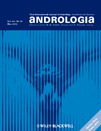Aneuploidy rate in spermatozoa of selected men with severe teratozoospermia
Summary
The aim of this study was to evaluate the incidence of spermatic aneuploidies in men with severe teratozoospermia and to determine an eventual relation between aneuploidies and a specific morphology of spermatozoa. Fluorescence in situ hybridisation (FISH) using a probe cocktail containing the alpha satellite for the centromeric region of chromosome X, Y and 18 was performed on decondensed spermatozoa from fresh ejaculates of thirty patients with severe teratozoospermia (abnormal forms >80%) and 15 fertile men with normal semen profiles. The mean frequency of teratozoospermia in patients was 91 ± 6.99%. There was statistically a significantly increased frequency of 1818, XY, XX and YY disomies in sperm with severe teratozoospermia compared with normal sperm (1.24% versus 0.08%, 1.42% versus 0.31%, 1.13% versus 0.19% and 1.11% versus 0.24%, respectively, P < 0.001 in all comparisons). The rate of total diploidy was significantly increased in patients compared with controls (1.46% versus 0.16%, P < 0.001). There was a correlation between macrocephalic spermatozoa and diploidy (r = 0.37, P < 0.05). Our data add further evidence that patients with severe teratozoospermia have an increased sperm aneuploidy rate and that this is particularly high in macrocephalic spermatozoa; FISH analysis on sperm could help to improve risk assessment and reproductive counselling in these individuals who are frequently candidates for intracytoplasmic sperm injection (ICSI) as a treatment of their infertility, as the use of ICSI has created consequential debate concerning the genetic risk for the offspring.




